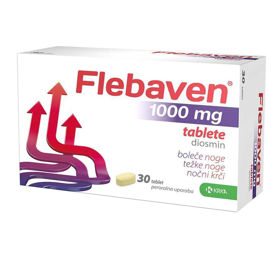Do you also stand a lot in your work? Or do you sit for hours - maybe even with your legs crossed? Have you gained a few pounds? Then you too are among the candidates for chronic venous disease, which progresses if we do not act in time.

Chronic venous disease is a disease of the legs in which the venous system of the lower extremities is affected. It occurs because the venous valves and walls weaken, so the valves cannot close tightly. Blood flows down, stagnates, and accumulates in the lower legs. The venous walls dilate and the plasma begins to penetrate the surrounding tissues, causing swelling.
|
Did you know that chronic venous disease is not just an aesthetic problem that makes us feel warmer, especially in the warmer months, due to its symptoms and signs? It is one of the most common non-communicable diseases, affecting as many as 8 out of 10 adults in the world. (1) |
In chronic venous disease we often talk about tired ,, heavy ,, painful in swollen legs . Although it is more common among women, it does not spare men either.
Eva, Diana and Veronika are among 80% of adults with similar problems.
|
"My legs are so heavy in the evening that I feel like I'm running a marathon." Eva , 39, lawyer
"The pain is so strong that I can't wait for the end of the day when I can finally rest my legs." Diana , 45 years old, hairdresser
"At the end of the day, I feel my shoes getting tighter and tighter because my feet are so swollen." Veronica , 67 years old, retired |
Factors contributing to the development of chronic venous disease
In addition to gender, the development of chronic venous disease is most influenced by family history, age and obesity. Other risk factors include prolonged standing or sitting, pregnancy, lack of exercise, smoking, fever.
Regardless of the cause of the disease, one of the most beneficial measures is regular exercise, especially walking. Physical activity is good for out health at all ages.
Use a simple questionnaire to check if you have chronic venous disease.
|
If you answered yes to several questions, you may have chronic venous disease. Ask your pharmacist or doctor for advice.
Prevent the progression of chronic venous disease! ACT NOW!
As chronic venous disease progresses, it needs to be treated as soon as possible as it can significantly impair quality of life. Severe pain and a feeling of heavy legs slowly increase emotional discomfort and reduce physical fitness and mobility.
It is beneficial to take venoactive drugs for all stages of chronic venous disease
Venoactive drugs increase venous tension and inhibit inflammatory processes in venous valves and walls. They also affect the permeability of capillaries and thus protect the microcirculation and reduce the risk of swelling.
Venoactive drugs also include Flebaven, which contains micronized diosmin of natural origin. Clinically proven to effectively reduce the most common symptoms and signs: leg pain, feeling of heavy legs and their swelling. (2) It is important that diosmin is micronized, as this process increases the absorption of the active substance and its effectiveness.
The effectiveness of Flebaven has been clinically proven!
|
After only 3 months of treatment with Flebaven, excellent results were shown.
|
Flebaven is available as 500 mg film-coated tablets and 1000 mg tablets.
1000 mg tablets are taken only once a day, allowing for better patient participation and more affordable treatment.
The text deals with over-the-counter medicine. Read all of this leaflet carefully before you start taking this medicine. Talk to your doctor or pharmacist about the risks and side effects.
References:
1. Rabe E, et al. Epidemiology of chronic venous disorders in geographically diverse populations: results from the Vein Consult Program. Int. Angiol. 2012; 31: 105–15.
2. Krevel B, Barbič-Žagar B, Uranič N. Efficacy and safety of a single dose of Flebaven (diosmin) 1000 mg daily in patients with chronic venous disease. Med Razgl 2020; 59 (1): 107–18.










